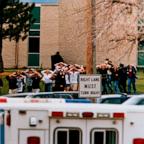U.S. Continues Afghan Bombing Raids
Oct. 8 -- The United States today launched bombs and missiles in a second consecutive day of attacks on targets in Afghanistan.
U.S. sources told ABCNEWS the Pentagon plans to bomb for three days and then will pause and see what happens. Under that scenario, Tuesday would be the end of the first phase of airstrikes but sources said a fourth and fifth day could be added if targets need to be restruck.
Military officials concede they may already be running out of targets that are worth dropping bombs on in Afghanistan.
While many of the targets were the same as those struck in the first attacks — air defense nodes, radars, tanks — fewer than half the U.S. aircraft used used Sunday participated in the attacks today, sources said.
There were reports that electricity to the Afghan capital, Kabul, was cut for the second night in a row, and news agencies reported anti-aircraft fire was visible in the night sky.
A senior Taliban Health Ministry official said six to eight people died in the first round of raids.
Part of a Strategy
U.S. officials previously stressed the Taliban has few "high value" targets that can be pinpointed from the air. Pentagon officials said a major objective of the attacks is to eliminate the Taliban's limited air defense capabilities that might threaten U.S. aircraft, including those used to airdrop humanitarian aid.
The Islamic Republic News Agency is reporting that the commander of the Taliban air force was among those killed by the first round of attacks.
Another U.S. objective was to alter the balance of forces in the country in favor of armed forces opposing Taliban, namely the Northern Alliance. The alliance, also known as the United Front, is a collection of rival, self-interested militia groups allied to oppose Taliban rule.
And there was evidence of some progress on that front. After the first round of strikes, Northern Alliance forces began efforts to cut off supply routes to Taliban controlled cities in the north and west. But those forces, many of them teenagers, are believed largely outnumbered and have yet to attack Taliban strongholds in the south.




